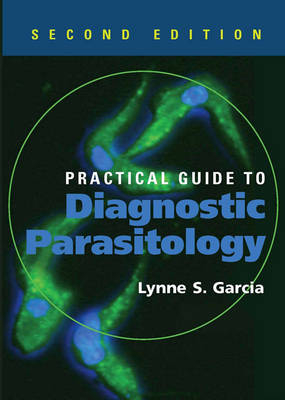
Practical Guide to Diagnostic Parasitology
American Society for Microbiology (Verlag)
978-1-55581-454-0 (ISBN)
- Titel ist leider vergriffen;
keine Neuauflage - Artikel merken
An essential training aid and reference guide for laboratorians.
Includes easy-to-follow collection and ordering guidelines and diagnostic techniques.
Offers extensive discussion and a table to assist physicians with ordering the most appropriate diagnostic tests.
Provides extensive information on method selection, clinical relevance, and test menus.
Features diagnostic algorithms, summary tables, and identification keys.
Presents comprehensive organism information on facing pages.
Includes how-to tips based on 30 years of the author's benchwork experience
Serves as a resource for microbiologists, physicians, medical technologists, public health personnel, teachers, and students.
This title is published by the American Society of Microbiology Press and distributed by Taylor and Francis in rest of world territories.
About ASM The American Society for Microbiology has over 30,000 members, including researchers, educators and health professionals, ASM is one of the largest life science societies in the world. Discover ASM books by internationally renowned authors and editors with expertise in a broad range of microbiology disciplines.
Table of Contents
Section 1. Philosophy and Approach to Diagnostic Parasitology
Why Perform This Type of Testing?
Who Should Perform Diagnostic Parasitology Testing?
Where Should Diagnostic Parasitology Testing Be Performed?
What Factors Should Precipitate Testing?
What Testing Should Be Performed?
What Factors Should Be Considered When Developing Test Menus?
Risk Management Issues Associated with STAT Testing
Section 2. Parasite Classification and Relevant Body Sites
Protozoa (Intestinal)
Protozoa (Other Body Sites)
Protozoa (Blood and Tissue)
Nematodes (Intestinal)
Nematodes (Tissue)
Nematodes (Blood and Tissue)
Cestodes (Intestinal)
Cestodes (Tissue)
Trematodes (Intestinal)
Trematodes (Liver and Lungs)
Trematodes (Blood)
Pentastomids
Acanthocephala
Table 2.1 Classification of Human Parasites
Table 2.2 Cosmopolitan Distribution of Common Parasitic Infections
Table 2.3 Body Sites and Possible Parasites Recovered
Section 3. Collection Options
Safety
Collection of Fresh Stool Specimens
Preservation of Stool Specimens
Collection of Blood
Collection of Specimens from Other Body Sites
Table 3.1 Fecal Specimens for Parasites: Options for Collection and Processing
Table 3.2 Approaches to Stool Parasitology: Test Ordering
Table 3.3 Preservatives and Procedures Commonly used in Diagnostic Parasitology (Stool Specimens)
Table 3.4 Advantages of the Thin and Thick Blood Films
Table 3.5 Advantages and Disadvantages of Buffy Coat Films
Table 3.6 Potential Problems of Using EDTA Anticoagulant for the Preparation of Thin and Thick Blood Films
Table 3.7 Body Sites and Possible Parasites Recovered
Section 4. Specimen Test Options: Routine Diagnostic Methods and Body Sites
Ova and Parasite Examination of Stool Specimens
Other Diagnostic Methods for Stool Specimens
Testing of Other Intestinal Tract Specimens
Urogenital Tract Specimens
Sputum
Aspirates
Biopsy Specimens
Blood
Culture Methods
Animal Inoculation and Xenodiagnosis
Antibody and Antigen Detection
Table 4.1: Body Site, Procedures and Specimens, Recommended Methods and Relevant Parasites, and Comments
Table 4.2: Serologic, Antigen, and Probe Tests Used in the Diagnosis of Parasitic Infections
Section 5. Specific Test Procedures and Algorithms
Microscopy
Ova and Parasite Examination
Fecal Immunoassays for Intestinal Protozoa
Larval Nematode Culture
Other Methods for Gastrointestinal Tract Specimens
Methods for Urogenital Tract Specimens
Preparation of Blood Films
Blood Stains
Blood Concentration
Algorithm 5.1: Procedure for Processing Fresh Stool for the O&P Examination
Algorithm 5.2: Procedure for Processing Liquid Specimens for the O&P Examination
Algorithm 5.3: Procedure for Processing Preserved Stool for the O&P Examination-Two-Vial Collection Kit
Algorithm 5.4: Procedure for Processing SAF-Preserved Stool for the O&P Examination
Algorithm 5.5: Use of Various Fixatives and Their Recommended Stains
Algorithm 5.6: Ordering Algorithm for the Laboratory Examination for Intestinal Parasites
Algorithm 5.7: Procedure for Processing Blood Specimens for Examination
Table 5.1: Body Site, Specimen, and Recommended Stain(s)
Table 5.2: Approaches to Stool Parasitology: Test Ordering
Table 5.3: Laboratory Test Reports: Optional Comments
Table 5.4: Parasitemia Determined from Conventional Light Microscopy: Clinical Correlation
Section 6. Commonly Asked Questions about Diagnostic Parasitology
Stool Parasitology
Tissues or Fluids
Blood
Section 7. Parasite Identification
Protozoa
Nematodes
Cestodes
Trematodes
Section 8. Identification Aids
Tables 8.1 to 8.37
Identification Keys 8.1 to 8.4
Figures 8.1 to 8.3
Plates 8.1 to 8.4
| Verlagsort | Washington DC |
|---|---|
| Sprache | englisch |
| Gewicht | 909 g |
| Themenwelt | Medizin / Pharmazie ► Medizinische Fachgebiete |
| Naturwissenschaften ► Biologie ► Genetik / Molekularbiologie | |
| ISBN-10 | 1-55581-454-9 / 1555814549 |
| ISBN-13 | 978-1-55581-454-0 / 9781555814540 |
| Zustand | Neuware |
| Haben Sie eine Frage zum Produkt? |
aus dem Bereich



